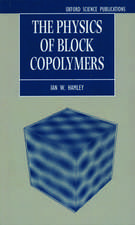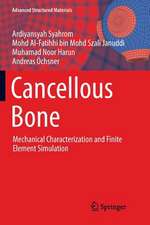A Numerical Approach to the Classical Laminate Theory of Composite Materials: The Composite Laminate Analysis Tool—CLAT v2.0: Advanced Structured Materials, cartea 189
Autor Andreas Öchsner, Resam Makvandien Limba Engleză Hardback – 8 iul 2023
The solution of the fundamental equations of the classical laminate theory is connected with extensive matrix operations, and many problems require in addition iteration loops. Thus, a classical hand calculation of related problems is extremely time consuming. In order to facilitate the application of the classical laminate theory, we decided to provide a Python-based computational tool, the so-called Composite Laminate Analysis Tool (CLAT) to easily solve somestandard questions from the context of fiber-reinforced composites. The tool runs in any standard web browser and offers a user-friendly interface with many post-processing options. The functionality comprises stress and strain analysis of lamina and laminates, derivation of off-axis elastic properties of lamina, and the failure analysis based on different criteria.
| Toate formatele și edițiile | Preț | Express |
|---|---|---|
| Paperback (1) | 828.05 lei 38-45 zile | |
| Springer Nature Switzerland – 9 iul 2024 | 828.05 lei 38-45 zile | |
| Hardback (1) | 993.12 lei 3-5 săpt. | |
| Springer Nature Switzerland – 8 iul 2023 | 993.12 lei 3-5 săpt. |
Din seria Advanced Structured Materials
- 18%
 Preț: 949.90 lei
Preț: 949.90 lei - 18%
 Preț: 1011.27 lei
Preț: 1011.27 lei - 18%
 Preț: 1014.28 lei
Preț: 1014.28 lei - 18%
 Preț: 1109.16 lei
Preț: 1109.16 lei - 18%
 Preț: 1034.17 lei
Preț: 1034.17 lei - 15%
 Preț: 713.69 lei
Preț: 713.69 lei - 18%
 Preț: 1007.35 lei
Preț: 1007.35 lei - 18%
 Preț: 899.21 lei
Preț: 899.21 lei - 18%
 Preț: 1116.26 lei
Preț: 1116.26 lei - 18%
 Preț: 1120.99 lei
Preț: 1120.99 lei - 18%
 Preț: 785.55 lei
Preț: 785.55 lei - 18%
 Preț: 894.46 lei
Preț: 894.46 lei - 18%
 Preț: 1222.01 lei
Preț: 1222.01 lei - 18%
 Preț: 792.66 lei
Preț: 792.66 lei - 18%
 Preț: 807.64 lei
Preț: 807.64 lei - 18%
 Preț: 1007.35 lei
Preț: 1007.35 lei - 18%
 Preț: 1120.18 lei
Preț: 1120.18 lei - 18%
 Preț: 1233.06 lei
Preț: 1233.06 lei - 18%
 Preț: 748.46 lei
Preț: 748.46 lei - 18%
 Preț: 1106.00 lei
Preț: 1106.00 lei - 18%
 Preț: 753.20 lei
Preț: 753.20 lei - 18%
 Preț: 780.82 lei
Preț: 780.82 lei - 18%
 Preț: 803.40 lei
Preț: 803.40 lei - 18%
 Preț: 798.18 lei
Preț: 798.18 lei - 18%
 Preț: 1123.35 lei
Preț: 1123.35 lei - 18%
 Preț: 901.64 lei
Preț: 901.64 lei - 18%
 Preț: 731.91 lei
Preț: 731.91 lei - 18%
 Preț: 947.04 lei
Preț: 947.04 lei - 15%
 Preț: 643.65 lei
Preț: 643.65 lei - 15%
 Preț: 639.25 lei
Preț: 639.25 lei - 15%
 Preț: 661.65 lei
Preț: 661.65 lei - 18%
 Preț: 953.82 lei
Preț: 953.82 lei - 15%
 Preț: 646.62 lei
Preț: 646.62 lei - 18%
 Preț: 1229.10 lei
Preț: 1229.10 lei - 15%
 Preț: 637.78 lei
Preț: 637.78 lei - 15%
 Preț: 651.84 lei
Preț: 651.84 lei - 15%
 Preț: 641.71 lei
Preț: 641.71 lei - 15%
 Preț: 649.22 lei
Preț: 649.22 lei - 15%
 Preț: 658.70 lei
Preț: 658.70 lei - 5%
 Preț: 719.59 lei
Preț: 719.59 lei - 15%
 Preț: 645.79 lei
Preț: 645.79 lei - 15%
 Preț: 646.43 lei
Preț: 646.43 lei - 18%
 Preț: 936.29 lei
Preț: 936.29 lei - 18%
 Preț: 1231.16 lei
Preț: 1231.16 lei
Preț: 993.12 lei
Preț vechi: 1211.12 lei
-18% Nou
Puncte Express: 1490
Preț estimativ în valută:
190.04€ • 203.21$ • 158.45£
190.04€ • 203.21$ • 158.45£
Carte disponibilă
Livrare economică 28 martie-11 aprilie
Preluare comenzi: 021 569.72.76
Specificații
ISBN-13: 9783031329746
ISBN-10: 3031329740
Pagini: 170
Ilustrații: XI, 170 p. 94 illus., 40 illus. in color. With online files/update.
Dimensiuni: 155 x 235 mm
Greutate: 0.25 kg
Ediția:2023
Editura: Springer Nature Switzerland
Colecția Springer
Seria Advanced Structured Materials
Locul publicării:Cham, Switzerland
ISBN-10: 3031329740
Pagini: 170
Ilustrații: XI, 170 p. 94 illus., 40 illus. in color. With online files/update.
Dimensiuni: 155 x 235 mm
Greutate: 0.25 kg
Ediția:2023
Editura: Springer Nature Switzerland
Colecția Springer
Seria Advanced Structured Materials
Locul publicării:Cham, Switzerland
Cuprins
1. Introduction.- 2. Classical Laminate Theory.- 3. Composite Laminate Analysis Tool - CLAT.- 4. Application Examples.- 5. Source Codes.
Notă biografică
Andreas Öchsner is Full Professor of Lightweight Design and Structural Simulation at Esslingen University of Applied Sciences, Germany. After completing his Dipl.-Ing. degree in Aeronautical Engineering at the University of Stuttgart (1997), he served as Research and Teaching Assistant at the University of Erlangen-Nuremberg from 1997 to 2003 while pursuing his Doctor of Engineering Sciences (Dr.-Ing.) degree. From 2003 to 2006, he was Assistant Professor at the Department of Mechanical Engineering and Head of the Cellular Metals Group affiliated with the University of Aveiro, Portugal. He spent seven years (2007–2013) as Full Professor at the Department of Applied Mechanics, Technical University of Malaysia, where he was also Head of the Advanced Materials and Structure Lab. From 2014 to 2017, he was Full Professor at the School of Engineering, Griffith University, Australia, and Leader of the Mechanical Engineering Program (Head of Discipline and Program Director).
Resam Makvandi is presently leading the computational department in the Acandis GmbH. He received his Ph.D. at the Institute of Mechanics, Otto von Guericke University of Magdeburg, Germany. He completed his B.Sc. degree at the Islamic Azad University, Ahvaz Branch, Iran (2010), and his M.Eng. degree at the University of Technology, Malaysia (2013), both in Mechanical Engineering.
Resam Makvandi is presently leading the computational department in the Acandis GmbH. He received his Ph.D. at the Institute of Mechanics, Otto von Guericke University of Magdeburg, Germany. He completed his B.Sc. degree at the Islamic Azad University, Ahvaz Branch, Iran (2010), and his M.Eng. degree at the University of Technology, Malaysia (2013), both in Mechanical Engineering.
Textul de pe ultima copertă
This book first provides a systematic and thorough introduction to the classical laminate theory for composite materials based on the theory for plane elasticity elements and classical (shear-rigid) plate elements. The focus is on unidirectional lamina which can be described based on orthotropic constitutive equations and their composition to layered laminates. In addition to the elastic behavior, failure is investigated based on the maximum stress, maximum strain, Tsai-Hill, and the Tsai-Wu criteria.
The solution of the fundamental equations of the classical laminate theory is connected with extensive matrix operations, and many problems require in addition iteration loops. Thus, a classical hand calculation of related problems is extremely time consuming. In order to facilitate the application of the classical laminate theory, we decided to provide a Python-based computational tool, the so-called Composite Laminate Analysis Tool (CLAT) to easily solve some standard questions from the context of fiber-reinforced composites. The tool runs in any standard web browser and offers a user-friendly interface with many post-processing options. The functionality comprises stress and strain analysis of lamina and laminates, derivation of off-axis elastic properties of lamina, and the failure analysis based on different criteria.
Caracteristici
Introduces a Python-based computational tool called CLAT Investigates elastic behavior and failure for unidirectional lamina Offers a systematic and thorough introduction to the classical laminate theory for composite materials






















